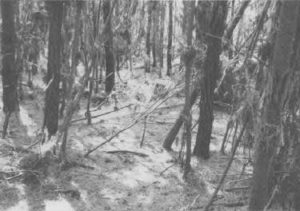- Author
- Swinden, Greg
- Subjects
- Biographies and personal histories, Early warships
- Tags
-
- RAN Ships
- HMAS Penguin I, HMAS Psyche
- Publication
- June 1997 edition of the Naval Historical Review (all rights reserved)
Suddenly I found myself in the cemetery. In a scene reminiscent of a Stephen King movie I surveyed my surrounds. Pine trees grew thickly and little light penetrated the canopy. Trees grew up through the middle of graves and headstones lay toppled to one side. The evidence of vandals was plain with several headstones smashed. Other graves were just patches of sunken ground. Here and there stood a grave in reasonable repair. I knew I was in the Roman Catholic Section as the map indicated it was the first section inside the gate to the left of the main path (which I had crawled along).
Armed with a pad of paper and a pen I started to write down the names on the few headstones that were left. Stoker Hanlon’s grave was not found on this occasion, but little did I know that I must have walked over it several times. With no chance of success on this day my family and I returned home – and none too soon my wife said as the place was giving her the creeps (and she stayed in the car the whole time!). Strike two on the search for Hanlon’s grave.
Further discussions with Nalda ensued. From the names on the headstones that were left and using the cemetery registers she thought it was possible to work out the rows and grave numbers and thus pinpoint the likely area that Hanlon’s grave was in. As she was soon to visit her son in Wollongong she said she would set aside a Saturday morning to help me look for the grave. The date was set at 9 June 1996. My wife decided she had had enough and would not accompany me on this third journey.
At 0800 on 9 June, I met with Nalda and her husband Maurice. Using the cemetery registers and the remaining headstones we started work and were soon able to work out the row/number system used in the cemetery. Logically Row A was closest to the path and moved back from there. Also logically the graves were numbered from left to right. When we found the spot where Hanlon’s grave should be we were disappointed as the plot was bare and the ground covered in rotting pine needles. Then Maurice noted a concrete corner poking out from the leaf litter. I began to pull back the pine needles; so thick and matted were they that it was like pulling off a thick blanket.

Then there it was. A concrete slab, in good repair, but with no headstone. However, there was the remains of a headstone which was the right length, width and stone to have been an official war graves headstone. There was also stamped in the bottom right hand corner of the slab the letters AWGS – Australian War Graves Service. We had found Stoker Hanlon’s grave. Nalda confirmed that Hanlon’s was the only war grave in the cemetery (which had over 2,000 graves), it was the right spot for the grave to be and it had the letters AWLS.
The next step was to write to the Office of Australian War Graves in Canberra, to advise them of the condition of Hanlon’s grave and suggest that it be repaired or relocated to the Naval Cemetery at Rookwood NSW. Included in my letter were copies of all my research documents, photos of the grave site and a map of the cemetery.
A few weeks later I was surprised to receive a phone call at work from the Foreman of the War Cemetery at Rookwood. He wanted to talk about Hanlon’s grave; however, I was quite busy and asked if I could call him back. He then advised me he was actually in the cemetery at Waterfall ringing on his mobile (who said mobile phones were only a yuppie fad!).
He told me he was using the map I had sent and thought he was in the Roman Catholic section, but could not find the concrete slab. I gave him some directions and prominent graves to look out for including that the slab was about halfway between a grave with surname France and another with the surname Poland (Hanlon therefore being buried halfway between France and Poland! – Sorry a little grave humour). I was later informed that he had found the grave site and had taken photos of it for the War Graves Office in Canberra. I was also advised that I would get a letter from them stating what they intended to do, but as Hanlon was already commemorated by a small plaque at Rookwood it was unlikely that anything would be done with the original grave site.




